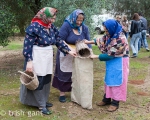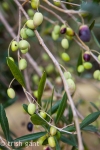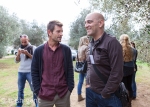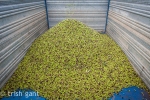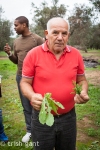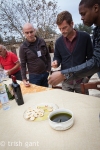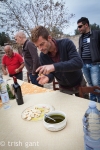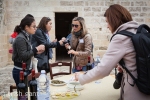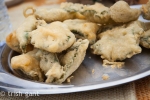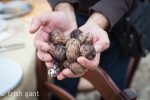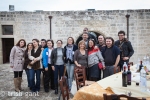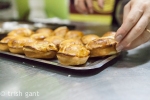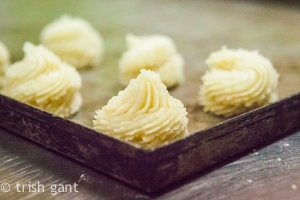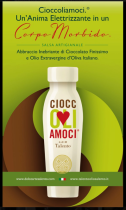They gathered together giggling like girls, four elderly ladies in traditional scarf and swooshy, full skirt. Brandishing a witches broom each, they demonstrated how they used to harvest olives in days gone buy. Gathering at the base of an olive tree, they swept across the surface of the earth, picking up the ripe fruit. They appeared to enjoy the attention and laughed.

We were visiting one of the many walled Masserias (co-operative farms) in the region, which were used as fortifications against the Turks and other invaders around the 1400’s. At around this time the Olive Crusher was developed too as serious oil production was established. Every olive tree was planted one by one and mostly worked by women to collect enough olives to make one litre of oil per day by hand. And this is the way it was done right up until the 1950’s.
Focussing on high quality meant that the olives that had fallen to the ground (Marcire or rotten) were ignored and used for lamp oil instead (exported from nearby Gallipoli). In fact,there are many myths about what makes a top quality Extra Virgin Olive Oil. Some say it’s the oil from the first pressing. Well that’s nonsense! It’s simply that the very best fruit is selected and is never pressed from olives which have already fallen to the ground. This oil is known worldwide for it’s fruity taste and delicate aromas, which can be used in bakery. High in polyphenols and anti-oxidants, its molecular structure is very important. At over 160 degrees celcius, the character of the oil changes.
Masserias are at the heart of Salentino culture. It is possible to get a really good meal here as well as shelter. Many serve as B&B’s too. Narduccio, an old boy from the farm, explained the British helped to restore many Masserias, keeping in line with the tradition of the outer walls being slightly lower that the fully grown olive trees.
Harvesting – Two Methods.
There are two ways to get olives from the tree. The Machine Grabber seizes the tree by the trunk and shakes it firmly, allowing the fruit to fall. There’s a down side to this method: damaging the trunk. Alternatively a kind of long-reach strimmer is used, which is by far the gentler way.
In the background, I caught Will learning to turn on a Lamboughini tractor….Lamboughini TRACTOR???
Gary, a British neighbour and married to an Italian, was on hand to do some interpreting for us. Us Brits appreciated a frank account of his trial by fire when he first moved here and had to fit in with the culture. He was very knowledgeable about the olive oil process, explaining that waiting too long to press the fruit results in the acidity content increasing. Extra Virgin is less than 1% acidity by definition. As the olives turn from green to black on the tree, the taste of the oil becomes more peppery: Fruitato – not peppery, Piccante – peppery. This produces interesting varieties of oil. Some types of olive are more acidic naturally. Gary explained that more acidic content can be carcinogenic and it’s common to graft on different cultivars for differing needs, perhaps medicinal, perhaps culinary and as he did so, he stooped down to pick up some Wild Borage.





